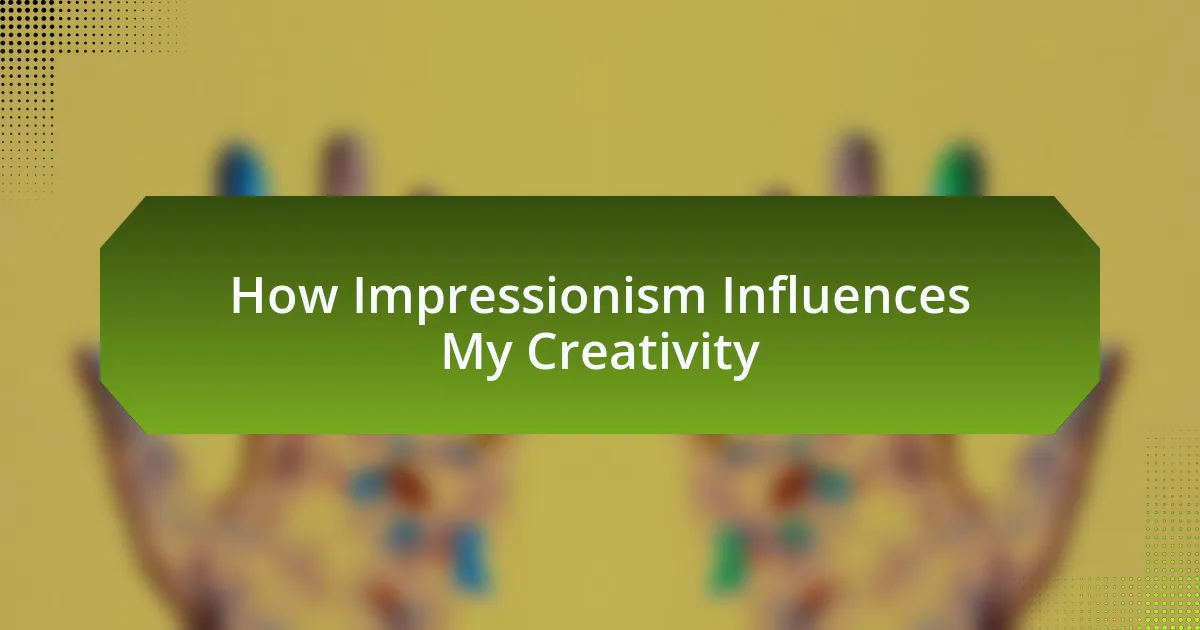Key takeaways:
- Impressionism emerged in the late 19th century, focusing on capturing fleeting moments and the interplay of light, emphasizing personal experiences and emotions in art.
- Key characteristics include loose brushwork and natural light, enabling artists to transform ordinary scenes into expressive visual poetry.
- Influential artists like Monet, Degas, and Renoir played crucial roles, each conveying distinct emotional depths and personal reflections through their works.
- The movement encourages spontaneity in creativity, inspiring artists to capture the essence of moments rather than adhering to traditional techniques and perfection.

Understanding Impressionism in Art
Impressionism, emerging in the late 19th century, challenged traditional artistic norms by focusing on fleeting moments and the interplay of light. This movement, which began with artists like Claude Monet and Pierre-Auguste Renoir, sought to capture everyday scenes, inviting viewers to experience the world as the artists saw it—vibrant and alive. I often wonder, how does a single brushstroke convey such emotion? This spontaneity evokes a sense of wonder that resonates deeply within me.
One of the hallmarks of Impressionism is its emphasis on capturing an instant in time, almost like a snapshot of life. I remember standing in front of Monet’s “Impression, Sunrise” and feeling a wave of tranquility wash over me. The colors were so blended yet distinct that the painting seemed to change with each passing moment, mirroring how we perceive the world around us. Isn’t it fascinating how a mere painting can evoke such a profound connection to our own experiences?
Moreover, the use of vibrant colors and bold brushwork invites viewers into a space where they can interpret their feelings. There’s something incredibly liberating about the way these artists broke free from rigid techniques to express their personal vision. When I see a painting filled with swirls of color, it feels as if the artist is sharing a piece of their soul, encouraging me to reflect on my own emotions in response to the world around me.

Key Characteristics of Impressionism
Impressionism is characterized by its loose brushwork, allowing the paint to express movement and light in ways that traditional techniques simply could not. I recall visiting an exhibition where a close-up of Van Gogh’s work revealed swirling patterns that seemed to dance off the canvas. Isn’t it striking how these seemingly haphazard strokes can create a vibrant atmosphere that draws you in?
Another key feature is the use of natural light to define mood and setting. I once viewed a piece by Renoir that captured a sunlit garden, and I found myself transported to a warm summer day. The way the light flickered across the figures and foliage made me question how light itself can evoke joy, nostalgia, and comfort all at once.
Furthermore, Impressionists often chose ordinary subjects, turning everyday scenes into visual poetry. I remember being captivated by a painting of people enjoying a picnic, which reminded me of my own family gatherings. The simplicity of the moment encourages us to find beauty in our daily lives, doesn’t it? This connection to the ordinary is what makes Impressionism resonate so personally with me.

Influential Impressionist Artists
When discussing influential Impressionist artists, it’s impossible not to mention Claude Monet. His iconic work, “Impression, Sunrise,” not only named the movement but also opened up a world where light became a primary character in painting. I remember standing before one of his water lily paintings and feeling as though I could step into that tranquil pond, fully enveloped by nature’s reflections.
Then, of course, there’s Edgar Degas, whose innovative compositions challenged how we view movement and dance. His ballet scenes, infused with an almost intimate perspective, make me think about the fleeting beauty of much-cherished moments. I often wonder how he managed to capture such grace and dynamism on canvas; it’s like he froze time just to evoke a feeling.
Lastly, Pierre-Auguste Renoir’s vibrant palettes and celebratory depictions of social life resonate with me deeply. I was once enchanted by his portrayal of people enjoying a sunny afternoon, which brought to mind my own cherished memories shared with friends. This ability to encapsulate joy and connection reminds us that art can be a profound reflection of our personal experiences, doesn’t it?

Emotions Evoked by Impressionism
The emotions evoked by Impressionism often feel like an intimate conversation. When I view a painting infused with quick brush strokes and soft colors, I am transported to a moment—like a summer afternoon where laughter echoes through the air. I can almost feel the warmth of the sun on my skin, reminding me of carefree days spent with loved ones. Isn’t it incredible how a mere painting can transport us back in time, allowing us to relive those cherished memories?
One of the most profound feelings I experience with Impressionist art is nostalgia. Take Monet’s depictions of gardens or tranquil waters; they often stir a longing for simpler times. I’ve found myself approaching these artworks and feeling the weight of years gone by, like I’m looking back on my own life’s beautiful fleeting moments. Don’t you ever wish you could pause time and soak in the beauty of a moment, like those captured on canvas?
There’s also an undeniable sense of serenity that comes from Impressionism. Whenever I gaze at a sunset painted by Renoir, the soft hues speak to my soul, offering a comforting escape from daily chaos. I remember a particularly stressful week when I stumbled upon one of his airy landscapes; it felt like a gentle whisper to slow down and appreciate the present. How often do we rush through life without pausing to appreciate its beauty? Impressionism reminds us to take a moment to breathe and enjoy the view.

Personal Experiences with Impressionist Art
Visiting an art museum filled with Impressionist masterpieces was a transformative experience for me. I recall standing before Van Gogh’s “Starry Night Over the Rhône,” feeling the pulsating energy of the stars as if they were whispering secrets to me. It struck me just how vivid the colors were, igniting a spark of inspiration within; I left that day feeling like I had connected with something profoundly larger than myself.
One summer evening, I spent hours outdoors, attempting to replicate the free spirit of Impressionist techniques on my canvas. As I dabbed the brush into vibrant paints, I felt a sense of liberation wash over me. The process was more than just painting; it was a meditative escape that drew me closer to my own emotions and the surrounding nature. Has there ever been a moment where art made you feel truly alive?
I often find myself returning to Impressionism during quiet times of reflection. Recently, I sat in my living room, admiring a framed print of Degas’s ballet dancers, and felt a rush of joy. It reminded me of my childhood dance lessons, where I would twirl across the studio floor, completely lost in the music. The art’s lively movement encapsulates fleeting moments of grace—moments that resonate deeply within me, teaching me to appreciate the beauty of movement both on and off the canvas.

How Impressionism Influences My Creativity
As I explore the world of Impressionism, I often find that its emphasis on capturing light and movement inspires my creative process. One evening, while experimenting with a palette of soft pastels, I suddenly realized that each brushstroke could evoke a fleeting moment in time—just as Monet did with his landscapes. Have you ever felt that your art could encapsulate an entire experience in just a few colors?
The spontaneity of Impressionism urges me to break free from rigid techniques and embrace exploration. I recall a rainy afternoon when I decided to paint a still life of flowers from my garden. Rather than obsess over precise details, I allowed myself to express the emotional essence of the blooms, channeling my feelings of nostalgia and warmth. What if we let go of perfection and simply embraced the joy of creation?
In my daily life, I channel the principles of Impressionism more than I realize. Whether I’m capturing the warm glow of sunset or the laughter of friends, I aim to represent the spirit of the moment rather than obsessing over how things “should” look. How often do we miss the beauty in everyday life by getting caught up in our expectations? Embracing Impressionism has taught me to seek spontaneity, turning even mundane scenes into vibrant stories on canvas.

Inspiring Impressionist Works to Explore
Exploring Monet’s “Impression, Sunrise” feels like stepping into a dream. The way the gentle hues blend together captures the dawn’s soft light, inviting me to reflect on moments of quiet beauty in my own life. Have you ever watched the sunrise and felt a sense of peace wash over you? I remember a morning where I sat by the lake, the sun just breaking the horizon, and it struck me how Monet could encapsulate that serene feeling on canvas.
Another piece that captivates me is Renoir’s “Luncheon of the Boating Party.” The vibrancy and joy of friendship depicted in this painting remind me of gatherings with dear friends on warm summer afternoons. I once hosted a picnic where laughter floated through the air like the music that played softly in the background. How do we capture such ephemeral moments? Renoir’s work inspires me to embrace these experiences, encouraging me to paint not just the scenes but the emotions that linger within them.
Then, there’s Degas’s ballet dancers, steeped in grace and motion. Each figure conveys a story of determination and elegance that stirs something deep within me. I recall attending a dance recital, mesmerized by the performers’ dedication, which echoed the energy in Degas’s work. How can we, as artists, convey that kind of movement and emotion? These pieces inspire me to explore the rhythm and flow in my art, turning mere observations into dynamic expressions of life.